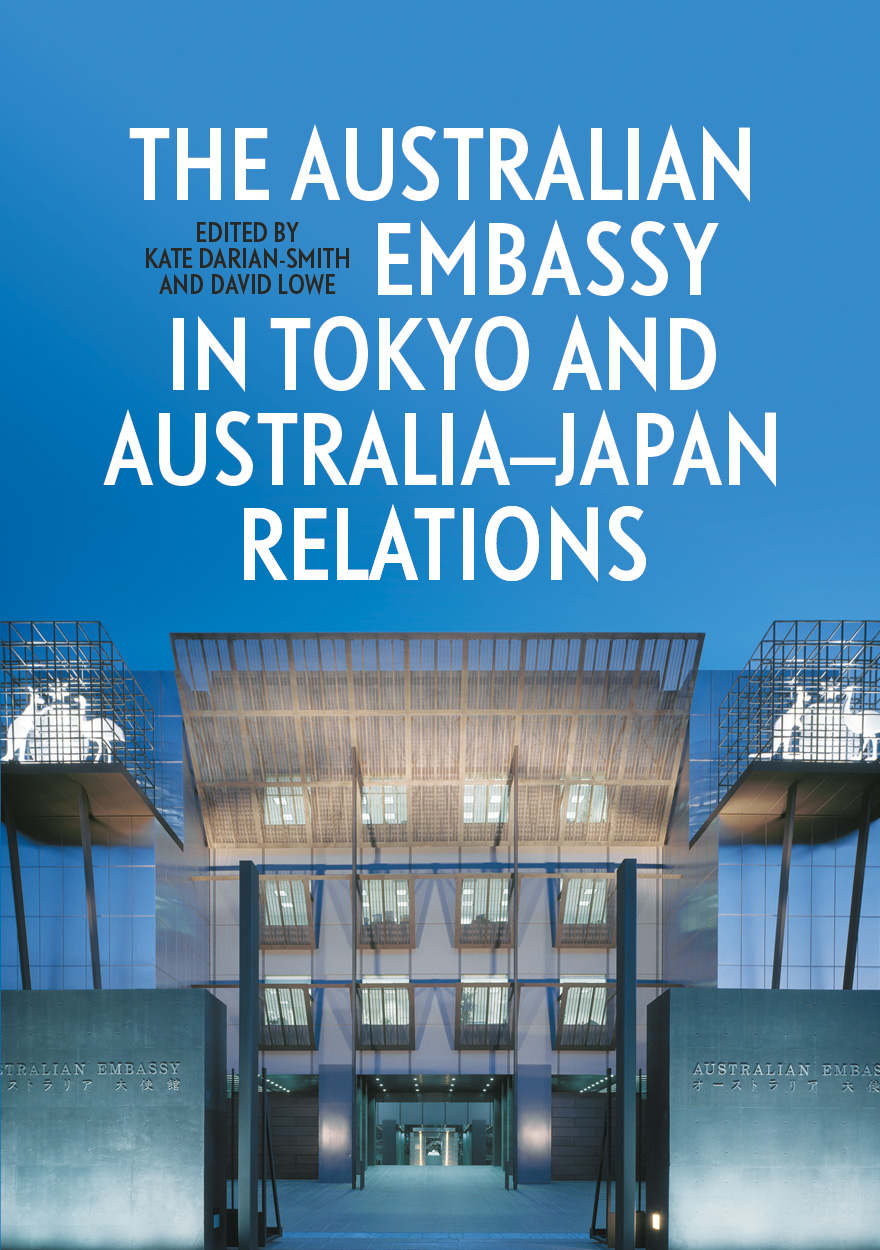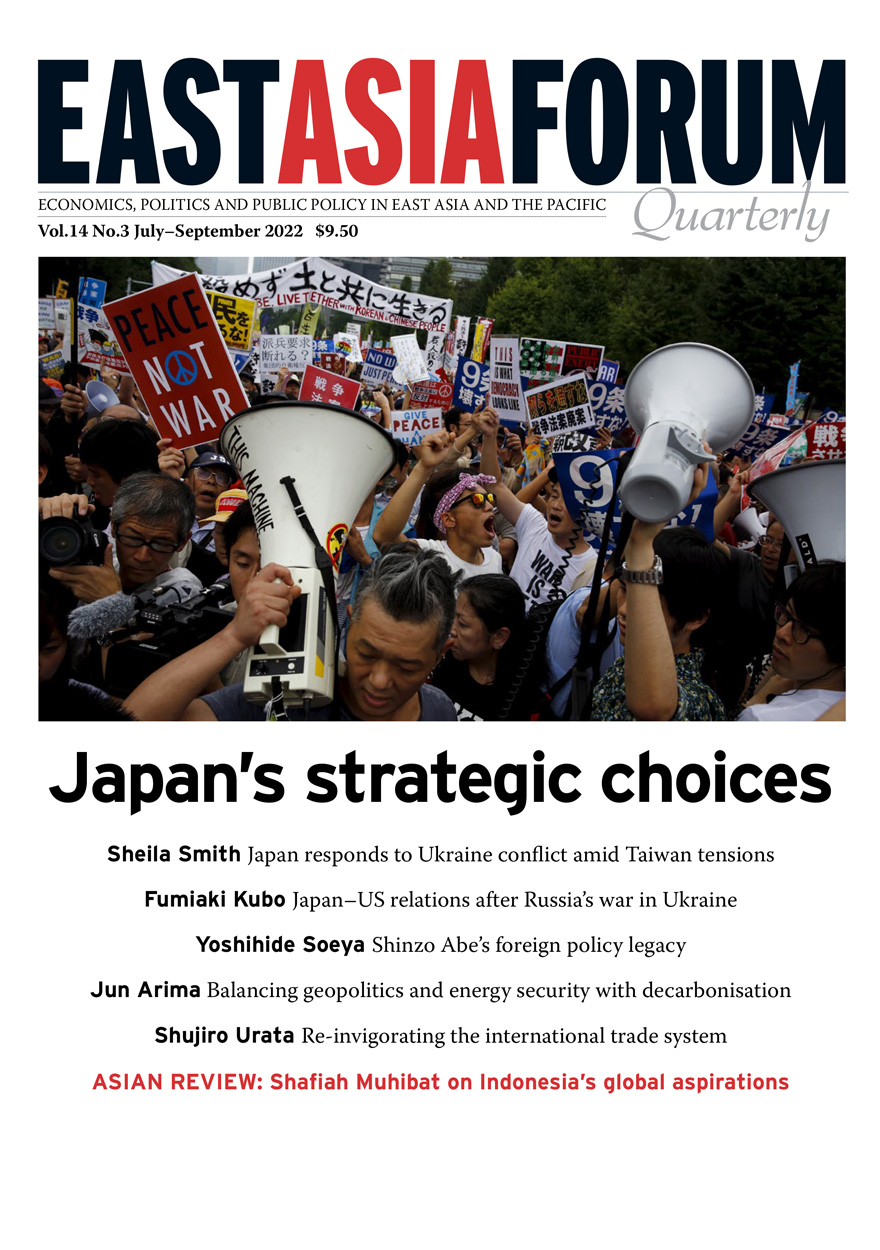Search titles
Displaying results 1 to 10 of 69.

East Asia Forum Quarterly: Volume 15, Number 3, 2023 »
Publication date: September 2023
As ASEAN and Japan celebrate the 50th anniversary of their official relationship, the challenge to redefine the goals and purpose of this relationship is now pressing. Great power rivalry, regional power relativities, and sweeping political and economic disruption have injected new dynamics and exposed serious vulnerabilities. With ASEAN member states and Japan each facing their own domestic challenges, the opportunity presents itself for a more 'equal' partnership that is able to 'co-create' a regional economy and society, from paternalistic origins. This issue of East Asia Forum Quarterly addresses these challenges for the ASEAN–Japan relationship and offers ideas, vision and initiatives that might guide its future: exploring the policy options for a relationship challenged by regional economic fragmentation; detailing the lessons available for policymakers beginning to act on sustainability and digital and green transformation; and examining the opportunities taken and thus far unrealised for the fashioning of new soft diplomacy and investment in intra-ASEAN infrastructure.
Download for free
Not available for purchase

The Australian Embassy in Tokyo and Australia–Japan Relations »
Edited by: Kate Darian-Smith, David Lowe
Publication date: March 2023
Relations between Australia and Japan have undergone both testing and celebrated times since 1952, when Australia’s ambassadorial representation in Tokyo commenced. Over the years, interactions have deepened beyond mutual trade objectives to encompass economic, defence and strategic interests within the Indo-Pacific region and beyond. This ‘special relationship’ has been characterised by the high volume of people moving between Australia and Japan for education, tourism, business, science and research. Cultural ties, from artists-in-residence to sister-city agreements, have flourished. Australia has supported Japan in times of need, including the aftermath of the 2011 Tohoku earthquake.
This book shows how the Australian embassy in Tokyo, through its programs and people, has been central to these developments. The embassy’s buildings, its gardens and grounds, and, above all, its occupants—from senior Australian diplomats to locally engaged staff—are the focus of this multidimensional study by former diplomats and expert observers of Australia’s engagement with Japan. Drawing on oral histories, memoirs, and archives, this volume sheds new light on the complexity of Australia’s diplomatic work in Japan, and the role of the embassy in driving high-level negotiations as well as fostering soft‑power influences.
‘With a similar vision for the Indo-Pacific region and a like-minded approach to the challenges facing us, Australia and Japan have become more intimate and more strategic as partners. I am very pleased to see this slice of Australian diplomatic history so well accounted for in this book.’
— Jan Adams AO PSM, Secretary, Australian Department of Foreign Affairs and Trade; Australia’s Ambassador to Japan, November 2020–June 2022

East Asia Forum Quarterly: Volume 14, Number 3, 2022 »
Publication date: September 2022
Japan ‘crossed the Rubicon’ after Russia’s invasion of Ukraine. Unlike eight years ago when Russia annexed Crimea, the Kishida government quickly implemented sanctions against Russia with other Western countries. Japanese people have generally stood behind the Kishida government’s foreign and security policy activism, yet uncertainties about Japan’s future remain. Can Japan confront ‘a three-front war’ against China, North Korea and Russia? How can Japan manage its relations with the United States and China amidst great power competition and a growing risk of military conflict? How can it cope with inflation, energy shortages, global warming and the crisis of the nuclear non-proliferation regime? Domestically, Japan has yet to escape from the impact of COVID-19. Maintaining international competitiveness in an era of ageing and shrinking population remains a top priority for Japan. The articles in this EAFQ examine the challenges and opportunities facing Japan and explore its future in an era of growing uncertainty.
Download for free
Not available for purchase

East Asia Forum Quarterly: Volume 14, Number 1, 2022 »
Publication date: March 2022
Economic cooperation in East Asia has progressed in its own distinct way, and the conclusion of the Regional Comprehensive Economic Partnership (RCEP) in 2019 is a huge achievement of strategic significance that pushes back against threats to the multilateral system. RCEP is the world’s largest regional pact in terms of GDP, trade volume, foreign direct investment and population. This issue of East Asia Forum Quarterly looks at RCEP going forward, the ways Asia’s largest economies are embracing the deal, the supply chain and manufacturing trends that are emerging and the RCEP framework for dealing with issues beyond those already negotiated.
Download for free
Not available for purchase

Japan at War and Peace »
Shidehara Kijūrō and the Making of Modern Diplomacy
Authored by: Ryuji Hattori
Publication date: December 2021
The question of how to maintain the continuity of diplomacy while developing democracy without military intervention is an old and new issue. The challenge can be described as a dilemma between democracy and diplomatic coherence. This dilemma is not unique to the twenty-first century; it has been a constant challenge to the development of democracy. In non-Western countries, democratisation originated in the nineteenth century and has had many successes and failures. After the Russo-Japanese War, political parties began to take power in Japan.
The best embodiment of diplomacy in Japan’s emerging democracy—the development of parliamentary democracy and mass-based democracy—is Shidehara Kijūrō (1872–1951), who served as foreign minister from 1924 to 1927 and from 1929 to 1931, and was prime minister from 1945 to 1946. As a diplomat from the Ministry of Foreign Affairs, Shidehara had long grappled with the issue of how to ensure diplomatic coherence in modern Japan, which was becoming increasingly democratic. Although Shidehara succeeded to some extent in promoting diplomacy in cooperation with the US and the UK under party politics, the rise of the military after the Manchurian Incident forced him to retire for a period. However, after the Pacific War, Shidehara became prime minister of the US-occupied Japan and attempted to restore cooperative diplomacy under party politics. Shidehara came to the conclusion that the way to achieve both democracy and diplomatic coherence was through nonpartisan diplomacy towards peace.
This book examines the tension between diplomacy and democracy, focusing on Shidehara’s life and exploring modern Japan’s footsteps. Shidehara was undoubtedly one of Japan’s most important diplomatic figures.

East Asia Forum Quarterly: Volume 13, Number 3, 2021 »
Publication date: September 2021
The 2020 Olympics put a spotlight on Japan’s crisis governance capabilities. Whether it be in the sphere of social issues, domestic political economy or foreign policy, Japan’s capacity to manage ‘slow-burn’ crises will be a primary test for the country’s policymakers and citizens alike in coming years. This edition of East Asian Forum Quarterly looks at these challenges, including the COVID-19 pandemic, digital governance, women’s rights in the #MeToo era, foreign policy, natural disaster response and tone-party control of Japan’s government.
Download for free
Not available for purchase

East Asia Forum Quarterly: Volume 12, Number 3, 2020 »
Publication date: September 2020
Japan's choices will be consequential — potentially pivotal — as the world moves through an inflection point in history. The United states and China are locking into strategic rivalry, with both countries dealing poorly with transition to a more multipolar order. How the rest of the world responds will determine global security, prosperity and stability for decades to come.
This issue examines how Japan will navigate the policy challenges associated with a post-COVID and post-Abe world. Our contributors offer a variety of perspectives on Japan’s global leadership role, domestic politics, health governance, diplomatic strategy and economic recovery. Our Asian Review pieces examine the domestic drivers of India’s foreign policy and the shaping of politics in China.
Download for free
Not available for purchase

Bridging Australia and Japan: Volume 2 »
The writings of David Sissons, historian and political scientist
Edited by: Keiko Tamura, Arthur Stockwin
Publication date: August 2020
This book is volume two of the writings of David Sissons, who first established his academic career as a political scientist specialising in Japanese politics, and later shifted his focus to the history of Australia–Japan relations. In this volume, we reproduce his writings on Japanese politics, the Pacific War and Australian war crimes trials after the war. He was a pioneer in these fields, carrying out research across cultural and language borders, and influenced numerous researchers who followed in his footsteps. Much of what he wrote, however, remained unpublished at the time of his death in 2006, and so the editors have included a selection of his hitherto unpublished work along with some of his published writings.
Breaking Japanese Diplomatic Codes, edited by Desmond Ball and Keiko Tamura, was published in 2013, and the first volume of Bridging Australia and Japan was published in 2016. This book completes this series, which reproduces many of David Sissons’ writings. The current volume covers a wide range of topics, from Japanese wartime intentions towards Australia, the Cowra Breakout, and Sissons’ early writings on Japanese politics. Republished in this volume is his comprehensive essay on the Australian war crimes trials, which influenced the field of military justice research. Georgina Fitzpatrick and Keiko Tamura have also contributed essays reflecting on his research.
Sissons was an extraordinarily meticulous researcher, leaving no stone unturned in his search for accuracy and completeness of understanding, and should be considered one of Australia’s major historians. His writings deal not only with diplomatic negotiations and decision-making, but also the lives of ordinary and often nameless people and their engagements with their host society. His warm humanity in recording ordinary people’s lives as well as his balanced examination of historical incidents and issues from both Australian and Japanese perspectives are hallmarks of his scholarship.

Fluid Matter(s) »
Flow and Transformation in the History of the Body
Edited by: Natalie Köhle, Shigehisa Kuriyama
Publication date: August 2020
Once upon a time, doctors across Eurasia imagined human beings in ways that strike us today as profoundly strange and alien. For over 2,000 years, they worried anxiously about fluids to which our modern doctors spare hardly a thought (such as sweat, phlegm and qi) and they obsessed over details (such as whether a person’s pores were open or closed) whose meaning and vital importance have now largely faded from memory. Through a series of case studies from Europe, India, China, Mongolia and Japan, Fluid Matter(s) suggests ways to make sense of this strange and dimly remembered past, and urges us to reflect anew on the significance of fluids and flows in the history of medicine.
The book also urges us, more generally, to reimagine the way in which we narrate history. The articles here are essays, in the original French sense. They are exploratory trials, experiments to illustrate some of the ways in which digital texts can go beyond the affordances of print. They test visual effects that are inconceivable on a paper page, but that are easily conjured on an electronic screen. Fluid Matter(s) is the first work of its kind: a study that narrates the body’s past in a form that embodies new futures for narrative.
Not available for purchase

Re-imagining Japan after Fukushima »
Authored by: Tamaki Mihic
Publication date: March 2020
The 2011 Tōhoku earthquake, tsunami and Fukushima nuclear disaster (collectively referred to as ‘3.11’, the date of the earthquake), had a lasting impact on Japan’s identity and global image. In its immediate aftermath, mainstream media presented the country as a disciplined, resilient and composed nation, united in the face of a natural disaster. However, 3.11 also drew worldwide attention to the negative aspects of Japanese government and society, thought to have caused the unresolved situation at Fukushima.
Spurred by heightened emotions following the triple disaster, the Japanese became increasingly polarised between these two views of how to represent themselves. How did literature and popular culture respond to this dilemma? Re-imagining Japan after Fukushima attempts to answer that question by analysing how Japan was portrayed in post-3.11 fiction. Texts are selected from the Japanese, English and French languages, and the portrayals are also compared with those from non-fiction discourse. This book argues that cultural responses to 3.11 had a significant role to play in re-imagining Japan after Fukushima.



